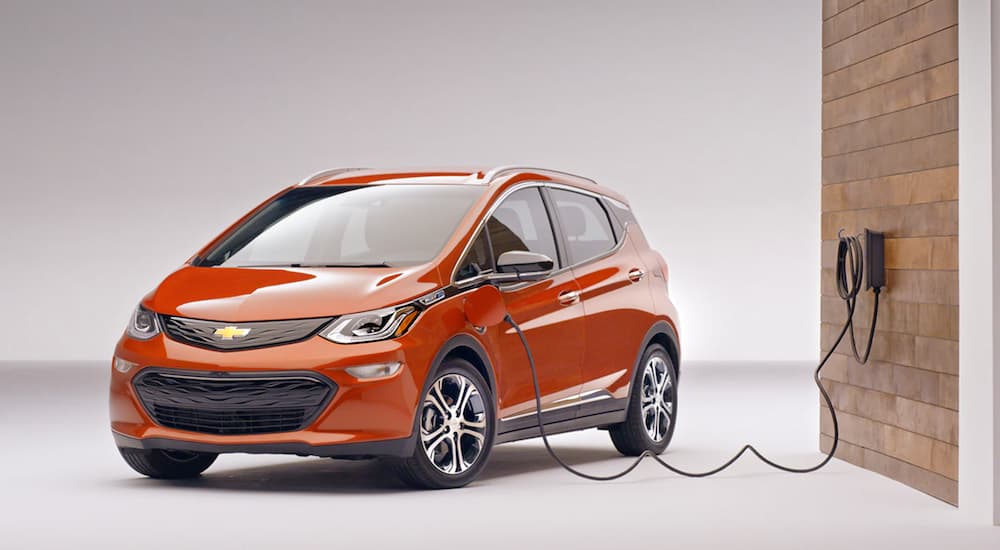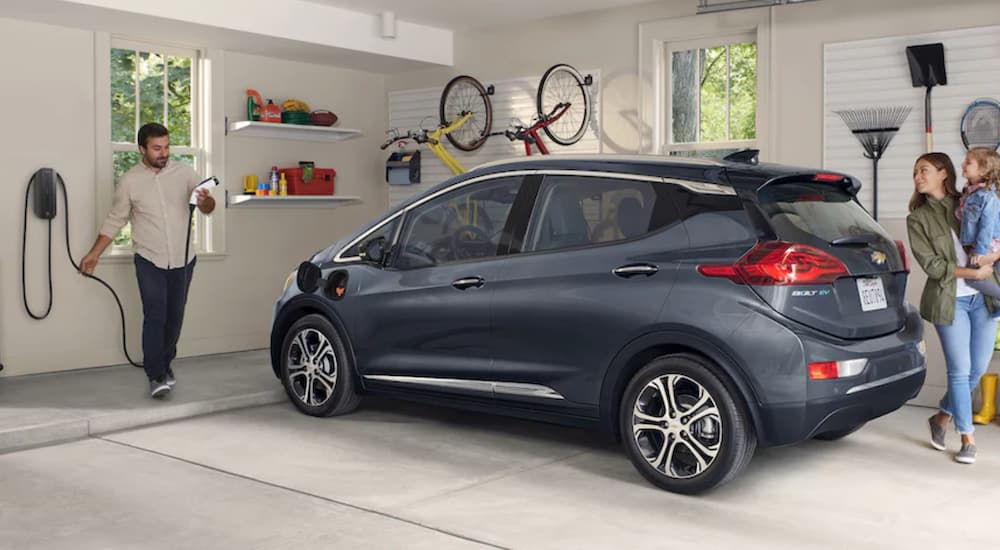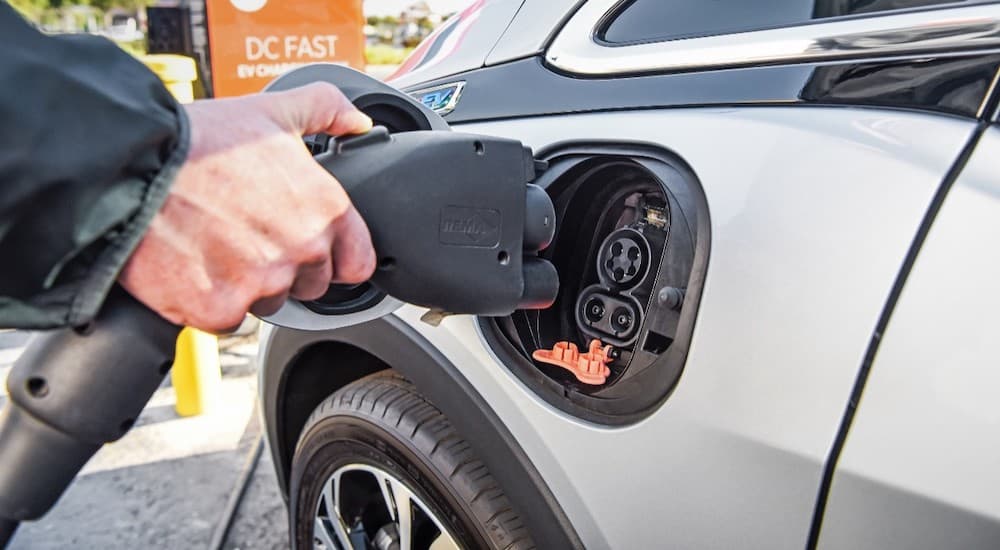Today, electric vehicles are more common than ever. You can even find affordable models at your local Nissan or Chevy EV dealer. If you are considering one of these futuristic vehicles, then you may be wondering just how much money you will save by not paying for gasoline. The cost for charging your electric vehicle varies greatly, depending on your location and the type of car you’re charging; however, you may spend as little as a third of your current gasoline expenses on keeping your electric vehicle charged at home. One of the great promises of EVs is that investing in one will greatly reduce your overall expenses for gasoline and maintenance.
But that doesn’t mean the EV you bring home won’t come with its own expenses. While the distance you can travel on a single charge is getting longer and longer thanks to advances in battery technology, electricity is not free. Many drivers worry that charging will be a bigger expense and hassle than stopping at a gas station. Major EV manufacturers like Tesla and Chevy have taken steps to make sure the recharging process is as simple as it can be, with different options to fit a variety of scenarios. While you might still want to review the process with your local EV dealer at the time of purchase, keeping your electric vehicle on the road is easier than ever, and it doesn’t require a lot of money, either.
The EV Charging Process
Since the late 1990s, several automobile manufacturers have introduced a plethora of electric vehicles. Some were hastily retired, while others remain on the road today. Therefore, drivers will find that some charging mechanisms and processes vary from EV to EV. While Tesla may be the most popular EV manufacturer today, they operate a proprietary charging system. Other manufacturers like Chevy and Nissan rely on a variety of third-party chargers.
The Chevrolet Bolt EV is a highly acclaimed, all-electric vehicle that has given drivers a new perspective on the EV concept. Introduced in 2017, the Bolt can travel well over 200 miles on a single full charge. This means that drivers no longer need to worry about charging their EVs several times a day, which is far more convenient for daily commuters, or those who run errands, carpool, or drive to and from a variety of destinations in a single day.
Like most EVs, Chevy’s can charge from a standard household 120-volt outlet, requiring nothing more than the portable charge cord included with the vehicle. However, it is slow – for each hour spent charging, the Bolt will gain approximately 4 miles of driving range. The most popular method of charging for the Bolt EV is an option 240-volt outlet that can be installed by any certified electrician. With one of these in your garage or driveway, you can simply plug in your vehicle overnight and have a full battery waiting for you the next morning.
Gasoline Budget vs Charging Budget
Just as there isn’t a set fuel mileage for all gasoline-powered cars, there isn’t an exact formula for electric vehicles. Driving style and environmental factors can impact how quickly any vehicle consumes its energy, regardless of the source. In the same regard, electricity, and gasoline similarly vary in price from town to town and provider to provider. We’ve all had the experience of finding gasoline at a lower price three blocks down from where we just fueled up, and we’ve all wondered why our electricity bill total wavers across the months when usage habits don’t change significantly.
To determine how much you spend on gasoline each month, you total up all of your receipts and charges from the gas station. To project what your expenses might look like next month, you would look at your vehicle’s average miles per gallon between city and highway driving, the number of gallons you can purchase at a time, and the number of miles you’ll be driving, multiplied by the current cost of gasoline.
For example, the average car gets roughly 25 miles per gallon with an average gasoline cost of around $2.50 per gallon, which works out to $0.10 per mile. Because the average driver travels around 13,500 miles a year, that requires 540 gallons of gasoline at the cost of roughly $1,350. Although those numbers will almost certainly not reflect your individual gasoline bill, it does give us a rough ballpark figure to compare against EV costs.
To calculate how much you spend on charging your EV each month, you’ll need to look at a few significant variables, including how much you’re paying per kilowatt-hour of electricity usage (a figure which can typically be found on your monthly statement), along with how often you charge your vehicle. That, in turn, depends on how many miles you need to drive each month.
Taking the 2021 Bolt EV as our example, this EV has a 66 kWh battery pack that provides a range of 259 miles. That works out to roughly 0.25 kWh per mile. Using the national average electricity cost of around $0.13 per kilowatt-hour, that translates into roughly $0.033 per mile. Over the 13,500 miles the average driver covers each year, the EV will only require around $446. That means that you will be spending roughly three times less powering your Chevy Bolt EV than you would be spending for an average gasoline vehicle.
Faster Methods of Charging
Chevrolet and many other EV manufacturers recommend the available 240 volt Level 2 charging unit. This method of charging provides around 25 miles of driving range per hour spent on the charger, making it highly efficient for those on the go. There is a caveat to this method, however. While some public charging stations offer this level of charge, it is impossible to get the same results at home unless drivers have a specific EV charging unit installed. Now you might be thinking that installing an EV charger in your home would be expensive, but that is not the case.
Chevy and other auto manufacturers have partnered with a variety of companies who specialize in these systems. In fact, you can order a 240-volt charger straight from the Chevy website for just $599, and any third party sites offer even more affordable options. The installation will require a certified electrician; however, the benefits are significant, and the total cost (including the charger) is not much more than $1000 dollars. That will likely pay for itself in around a year and will also increase your home’s overall value.
The last method of charging the Bolt EV is the available DC Fast Charging, known across the industry as Level 3. With a charging rate of approximately 100 miles per 30 minute charge period for Bolt drivers, it’s easy to see how this could be a helpful option for those who are constantly on the go. However, Level 3 chargers are only found at public charging stations, and they usually cost significantly more to use.
When it comes to Level 3 charging costs, there are many factors to consider. Public charging systems usually charge not just for charge time but for time spent plugged in, but not charging. This “idle time” can be more expensive than the fee for using the station, which means drivers need to be conscientious about their public charging habits. There are several apps available that allow drivers to consider their current range, nearby charging stations and rates, and other considerations, such as parking structure fees, in order to help them find the most cost-effective option. Further, since you can easily charge at home, you will likely never use a Level 3 charger unless you are on a long road trip.
Save Time and Money with an EV
While there’s no flat rate for charging an EV at home, determining your monthly expenses for switching to electric requires just a bit of simple math. Drivers may find themselves trading their familiarity with which gas stations have the best prices and reward programs for their hourly electricity costs and EV range details. While the formulas used to determine miles per fuel unit (gallon or charge hour) and cost per mile isn’t too different, they do require us to think about how we keep our vehicles on the road.
No one wants to run out of gas, charge, or monthly budget, so it’s important to consider usage and cost on a regular basis. In the earlier examples, driving a gasoline-powered vehicle required $1350 in gas each year, while the EV used only $447 of electricity, but those figures are based on national averages, not your specific situation. Your local rates and prices will be far more accurate for predicting your estimated costs. For many drivers, though, going electric can provide significant savings.






